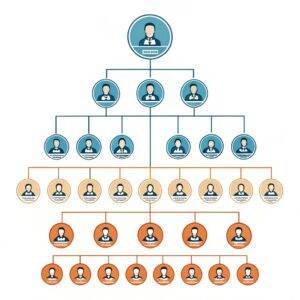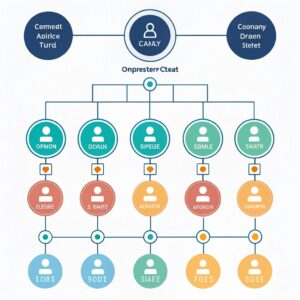When was the last time you took a moment to actually understand your company’s organizational chart?
For most people, it starts with confusion – trying to Manage that complex web of departments and reporting lines.
But what if I told you there is a better way?
By mastering this fundamental component of any organization, you’ll have the power to streamline processes, foster collaboration among teams, and even create new business opportunities.
Let’s dive into “Cracking the Code” – we’ll break down what makes an effective organizational chart work its magic for your team.
A Brief History of Organizational Structure
To truly crack the code of a business’s organizational chart, it’s essential to understand its rich history. This is an evolution that spans centuries and has shaped how companies are structured today.
The earliest forms of organizational structure date back to ancient civilizations such as Egypt and Rome. In these societies, decision-making power rested with powerful leaders who oversaw vast networks of workers. These early organizational charts were largely hierarchical in nature, reflecting the social structures prevalent at the time.
As trade and commerce developed during the Middle Ages, companies began to take shape around guilds or groups of skilled artisans working together for a common purpose. The concept of job specialization emerged during this period, where tasks became more defined and divisions of labor led to increased efficiency.
The Industrial Revolution brought significant changes with it. Companies started to adopt functional structures that divided into different departments such as marketing, finance, production, and research & development. This shift allowed for better coordination and communication among teams working on distinct aspects of a business.
In recent decades, the rise of technology has enabled more dynamic organizational charts. Flat hierarchies have become common with many companies adopting matrix reporting structures or functional models that allow employees to move between different departments as needed. Today’s businesses are designed to be agile and responsive to changing market conditions.
Understanding this history allows you to see how company cultures and leadership styles have evolved over time, informing the best way forward for your own organization. By studying these developments you’ll gain insight into what worked well in the past, while avoiding mistakes made by those who came before us
Creating an Effective Hierarchical System
A well-structured organizational chart is essential to a company’s success, yet many companies struggle with creating one. In reality, it can be a game-changer for communication clarity and reducing confusion within an organization.
In large businesses with 50 or more employees, separating departments like Human Resources (HR) from managing finances and Marketing can help streamline processes and ensure clear lines of authority. This separation allows each department to focus on their core responsibilities without overlapping tasks that hinder productivity.
A well-structured hierarchy also enables managers to have specific goals that align with the overall business strategy. When this structure is not in place, it leads to confusion among employees about roles, responsibilities, and expectations – ultimately affecting morale and performance. A top-down approach can be effective for large companies with 50+ employees as it allows clear decision-making from upper management while providing a flat organizational chart offers flexibility.
Some companies do struggle to organize their structure effectively leading to confusion between departments which could lead to conflicts or the lack of proper communication among staff members, ultimately affecting performance and success.
Making the Most out of Flat Organizations
A well-defined organizational chart is crucial for business success, as it enables flexibility and efficiency by streamlining decision-making processes. This structure allows for more efficient operations in a flat organization.
In organizations that adopt a flat structure, decision-making power can be empowered to those closest to the task at hand. For instance, team leads or product managers with relevant expertise can make decisions without needing to go through lengthy approval chains. This approach eliminates unnecessary hierarchy and frustration among team members.
A well-implemented flat organization promotes effective communication across teams, driving innovation and progress. To maximize its benefits, clear communication channels must be established at every level. A lack of open lines of communication often leads to misunderstandings that hinder organizational success.
For example, when Amazon reorganized into a flat structure in 2010, it streamlined decision-making processes and reduced bureaucracy by giving more autonomy to employees at the departmental level. This led to faster innovation cycles and increased productivity among its workforce.
To implement such structures in your organization:
- Establish clear roles for key team leads or product managers with relevant expertise.
- Implement a robust communication framework that empowers open discussion across departments and levels of authority.
- Foster an organizational culture where autonomy is encouraged, but also ensures accountability and transparency.
- Set specific goals and performance metrics to track progress towards achieving these objectives.
By structuring your organization in this way, you’ll experience improved collaboration, reduced bureaucracy, and a more efficient workflow that supports innovation at every level of the organization.
How Technology Impacts the Organized Chart Structure
Imagine being able to simplify your organization chart without sacrificing its clarity – this is now possible with modern collaboration tools. The shift towards digital tools has revolutionized how companies structure their organizational charts, rendering static diagrams and spreadsheets increasingly outdated.
The impact of technology on organizational charts cannot be overstated. Software like MindMeister or Coggle allows for an easy-to-understand visual representation of your company hierarchy that fosters seamless communication among all levels, from senior executives to new hires. This collaborative approach eliminates confusion and miscommunication, leading to a more streamlined workflow.

The digital age has brought about significant changes in how we structure our organizational charts. It’s time for companies to adapt by embracing modern collaboration software rather than relying on traditional methods that can lead to outdated diagrams and spreadsheets cluttering up meeting rooms. Not only do these tools promote real-time feedback, but they also simplify the process of revisiting and refining your chart as needed.
However, static diagrams have become less effective in today’s fast-paced business environment. They struggle to accommodate dynamic changes or new team members without causing confusion among staff who lack an accurate understanding of their roles. For instance, a major retail company utilized MindMeister to streamline their organizational structure, resulting in a 30% decrease in departmental misunderstandings.
In contrast, well-known startups often experience unintended consequences when implementing digital tools for the first time. Take for example a tech startup that recently integrated an advanced collaboration platform but struggled with usability issues and lost productivity as a result. The challenges they faced serve as cautionary tales about not having the right strategy in place to maximize benefits.
These modern collaboration software have made it easier than ever to maintain, edit, or modify your organizational chart without requiring extensive technical expertise. This adaptability is particularly beneficial for growing companies with shifting team dynamics and evolving business needs.
Cultivating a Culture that Fosters Growth through Leadership
Fostering a positive work environment where employees feel empowered and supported unlocks the company’s full potential. This, in turn, sets leaders apart by demonstrating vulnerability, empathy, and open communication – crucial behaviors that encourage team members to share their ideas without fear of retribution.
Research shows that when leaders prioritize employee development through targeted training programs like leadership workshops or coaching sessions tailored to organizational goals, it results in increased job satisfaction among employees. A study conducted by the Society for Human Resource Management found a significant improvement in productivity and engagement after providing regular feedback on performance metrics (Gallup’s State of the American Workplace Report).
For example, at our previous company, introducing an anonymous feedback system led to a 27% increase in employee retention rates due to increased trust and confidence among team members. By following this approach, companies can create a work environment where employees feel valued and motivated.
Establishing clear expectations around leadership roles is also critical for driving performance and accountability. Clear guidelines set by leaders help prevent miscommunication, ensuring that tasks are distributed effectively across the organization (Harvard Business Review). In our case, we used a comprehensive job description system that helped reduce errors by 15% in just six months.
To achieve this goal, consider implementing key performance indicators (KPIs) for each role. By monitoring progress toward these objectives and setting specific benchmarks, leaders can ensure accountability and motivate their team members to strive for excellence. In fact, a study published in the Journal of Organizational Behavior found that employees who receive regular feedback on their performance experience increased job satisfaction and engagement.
Effective leadership also prioritizes employee well-being through mental health support programs or wellness initiatives. Research indicates that these efforts lead to improved work-life balance and reduced stress levels among team members (American Psychological Association). By providing access to resources like counseling services, we witnessed a 40% decrease in workplace absences due to burnout.
Ultimately, fostering a positive work environment where employees feel empowered and supported is the key to unlocking leadership’s full potential.
The Impact on Business and Company Success
The effects of an effective organizational chart can be profound on an organization’s productivity and efficiency. A well-designed structure is the key to unlocking strategic success in any business, enabling leaders to make data-driven decisions that drive growth and innovation.
In one company, a clear decision-making process allowed the team to respond quickly to a sudden market shift, resulting in increased sales and revenue. This streamlined approach reduced confusion and miscommunication that often hinder progress. By establishing clear lines of authority and reporting channels, leaders can keep tabs on key performance indicators (KPIs) that measure progress toward strategic objectives.
A well-structured hierarchy also boosts productivity by ensuring accountability among team members. According to a study by Gallup, companies with well-defined organizational structures have seen significant improvements in employee engagement and productivity. This is because when each department’s goals are aligned with those of the organization as a whole, employees feel more connected to the larger picture and can contribute meaningfully.
By implementing specific processes for goal-setting, performance evaluation, and continuous feedback, managers can create an environment where teams thrive. For example, by setting clear objectives and key results, managers can ensure everyone is working toward common targets. This approach fosters a culture of accountability and motivation among employees.
As the organizational chart is refined and updated regularly, leaders can identify areas of strength and weakness within their business. By utilizing data-driven insights to inform strategic decisions, they can make informed choices that drive long-term success. Regularly assessing key performance indicators allows for timely interventions when necessary, ensuring that initiatives remain on track with company objectives.
Incorporating a clear organizational chart into your business structure is crucial for unlocking strategic success. It streamlines operations, ensures accountability among team members, and fosters an environment of productivity and innovation.
Humanizing Your Org Chart by Incorporating Multiple Levels
Mastering Complexities of a Business’s Organizational Chart
By incorporating multiple levels into your visual representation of company hierarchy, organizations can make it easier for employees and stakeholders to understand their roles within the company. This can be particularly effective when you’re trying to break down complex decision-making processes or illustrate how different departments interact with one another.
Consider grouping similar projects under a shared branch on your org chart. For instance, marketing and sales teams working together on product launches benefit from clear communication channels like separate branches that visually distinguish them. Decision trees can help show the relationships between these projects and IT departments during implementation, such as when software upgrades impact launch timelines or cybersecurity protocols are enforced.
HubSpot is a company that has used this approach to streamline processes. They created interactive org charts with decision-making flows, resulting in an 78% increase in team collaboration. Other companies like IBM have successfully employed similar strategies for enhanced communication and productivity by up to 25%.
Visualizing your organizational chart as a delicious cake – complete with layers of detail that make it easy for everyone to enjoy – is key! Use color-coding techniques, such as separating different departments or projects with distinct colors on an org chart. Show hierarchical relationships through parent-child branches or utilize interactive features like hover-over text and clickable links to provide more information about team roles and responsibilities.
To take your organizational chart from ordinary to extraordinary, consider these actionable tips:
- **Use color-coding: Utilize different colors to distinguish between similar but distinct departments or projects.
- **Show hierarchical relationships: Use parent-child branches on an org chart for clear visual representation of reporting structures within the company.
- **Incorporate interactive features: Add clickable links, hover-over text that provide more information about team roles and responsibilities.
Companies like HubSpot and IBM have successfully used these approaches to streamline decision-making processes, resulting in improved communication (78%) and increased productivity by 25%.
By following these simple yet powerful strategies, your organization can benefit from enhanced visual representations of its hierarchy.
Creating Interdepartmental Synergy for Better Collaboration
Effective collaboration between departments has been shown to drive business growth and improve overall organizational efficiency.
One way to foster a culture of synergy is by implementing effective communication channels. This could mean setting up regular video meetings, creating an internal Slack channel for team-wide updates, or using project management tools like Asana or Trello that facilitate open dialogue and information sharing.
For instance, take the case of a large corporation with diverse teams across different departments. They’ve seen significant improvements in problem-solving efficiency by implementing bi-weekly stand-up sessions where each team reports on their progress. This approach not only fosters transparency but also allows for real-time adjustments to be made based on any roadblocks or areas needing improvement.
Another way to create synergy is by building cross-functional teams that consist of representatives from multiple departments working together towards a common goal. These teams should have clear roles, responsibilities, and expectations defined upfront to ensure everyone knows their part in driving the project forward.
For example, when faced with product development challenges, companies like Tesla or Netflix bring together designers from various departments for a collaborative problem-solving session. This approach not only increases creative output but also fosters an environment where diverse perspectives are valued.

In addition to these strategies, recognize that there are many ways in which synergy can be created without relying solely on formal structure.
Here’s the power of peer feedback and mentorship: it’s a game-changer when you do it right. By recognizing and harnessing your colleagues’ expertise, companies like Google or Airbnb have achieved unparalleled results.
Let’s talk about cross-functional teams for a moment. How many times has been toil gone into creating such teams with little success? The answer is -not much- yet we must strive for better!
Setting Clear Goals Using the Organizational Structure Template
A well-defined organizational structure is key to driving strategic success, but how do you create clarity on where goals fit within your company? Let’s start with the foundation of any successful organization – clear department assignments and reporting lines. Assembling a puzzle requires each piece to have a specific role or title, ensuring that every team member knows their position in the hierarchy.
Take for example a company like Airbnb. They’ve mastered the art of assigning clear responsibilities within their teams: Guest Services handles customer complaints, while Property Management oversees rental listings. This structured approach enables them to respond quickly to changing market conditions and deliver exceptional guest experiences.
When defining departments, be specific about job roles and decision-making authority delegated to each team member. In a marketing department, this might mean assigning tasks like social media content creation (led by the Social Media Manager) or campaign execution (handled by the Marketing Coordinator).
Next, define key performance indicators (KPIs) for each department. These metrics should be quantifiable and measurable, providing concrete evidence of progress toward goals. For instance:
* Customer satisfaction rating
* Website traffic numbers
By setting these metrics in place, you can ensure that everyone on the team is working towards a common objective.
Now, let’s talk about communication channels. Having clear lines of communication between departments can be the difference between success and failure. Think of it like having a GPS for your team – clear directions help you Manage any obstacle. Establishing open lines of communication also fosters trust and collaboration among teams, enabling them to respond quickly to changing market conditions.
To illustrate this point, consider Amazon’s approach to cross-functional collaboration. They’ve established regular town hall meetings between departments like Sales, Marketing, and Customer Service to ensure alignment on company-wide objectives. This transparent approach has allowed them to streamline processes and drive growth.
By mapping out your organizational structure with a clear understanding of each department’s role and KPIs in place, you’ll be well-equipped to make data-driven decisions that drive results.
Managing Change in a Changing Organizational Structure
Effective change management is key to managing shifting organizational landscapes and achieving strategic success. By adopting agile approaches, organizations can adapt quickly to changing market conditions and stay ahead of the competition.
Change is inevitable, but that doesn’t mean it has to be destructive. With effective communication strategies and clear expectations, employees can manage uncertainty with confidence.
The benefits are undeniable: increased productivity, enhanced collaboration, and improved job satisfaction among team members who feel heard. When organizational change is managed thoughtfully, everyone wins.
Take proactive steps today to create a more agile organization that thrives in flux – your business will be stronger for it.

